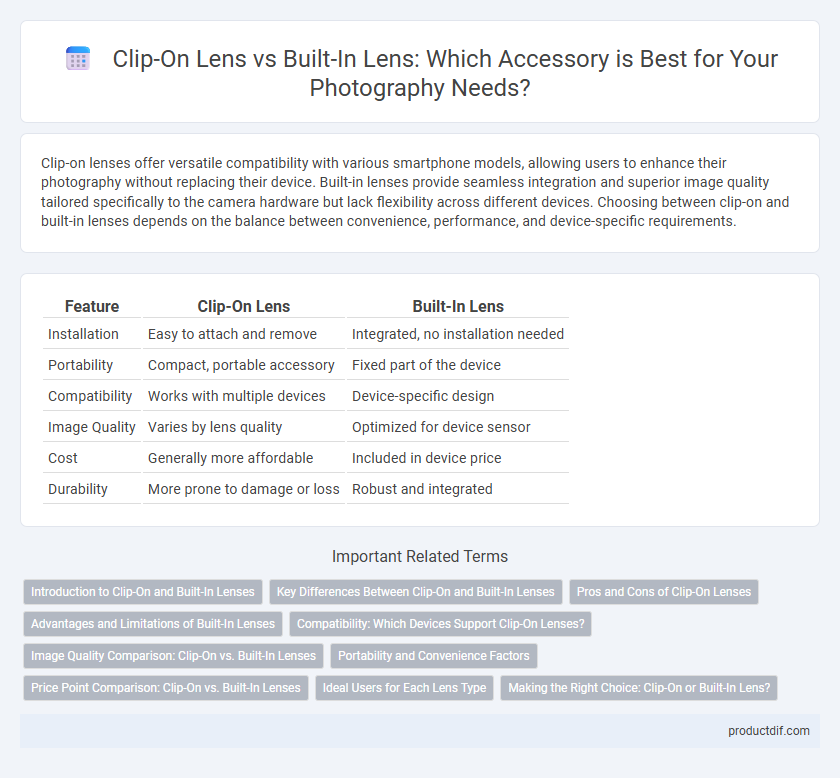Clip-on lenses offer versatile compatibility with various smartphone models, allowing users to enhance their photography without replacing their device. Built-in lenses provide seamless integration and superior image quality tailored specifically to the camera hardware but lack flexibility across different devices. Choosing between clip-on and built-in lenses depends on the balance between convenience, performance, and device-specific requirements.
Table of Comparison
| Feature | Clip-On Lens | Built-In Lens |
|---|---|---|
| Installation | Easy to attach and remove | Integrated, no installation needed |
| Portability | Compact, portable accessory | Fixed part of the device |
| Compatibility | Works with multiple devices | Device-specific design |
| Image Quality | Varies by lens quality | Optimized for device sensor |
| Cost | Generally more affordable | Included in device price |
| Durability | More prone to damage or loss | Robust and integrated |
Introduction to Clip-On and Built-In Lenses
Clip-on lenses offer versatile attachment options compatible with various smartphones, enhancing photography with macro, wide-angle, or fisheye effects without altering the device. Built-in lenses are integrated into cameras or smartphones, designed for optimal image quality and seamless user experience through fixed or zoom capabilities. Both lens types serve distinct needs, with clip-on lenses providing flexibility and built-in lenses ensuring compactness and durability.
Key Differences Between Clip-On and Built-In Lenses
Clip-on lenses offer versatile, easily attachable options compatible with various smartphones, enhancing photography without requiring device modifications. Built-in lenses provide optimized image quality through precise integration with the phone's camera system, delivering superior optical performance and faster autofocus. Key differences include portability, image stabilization, and user convenience, with clip-on lenses excelling in adaptability and built-in lenses excelling in seamless hardware functionality.
Pros and Cons of Clip-On Lenses
Clip-on lenses offer versatility by easily attaching to various smartphones, enabling users to enhance their photography with macro, wide-angle, or fisheye effects without needing a dedicated device. These lenses are lightweight, portable, and affordable, making them ideal for casual photographers seeking creative options. However, clip-on lenses may suffer from alignment issues, reduced image quality due to additional glass elements, and limited durability compared to built-in lenses engineered specifically for a device.
Advantages and Limitations of Built-In Lenses
Built-in lenses offer seamless integration with the camera body, providing optimized optical performance tailored for specific devices, ensuring consistent image quality without the need for additional attachments. However, their fixed design limits versatility, restricting focal length options and sometimes resulting in less flexibility compared to clip-on lenses, which can be swapped to achieve different effects. Maintenance and repair of built-in lenses can be more complex and costly, as they are integral to the camera's hardware.
Compatibility: Which Devices Support Clip-On Lenses?
Clip-on lenses offer versatile compatibility with a wide range of smartphones, tablets, and some compact cameras, as they attach externally to the device's existing camera, making them ideal for users with multiple devices or older models lacking advanced lenses. Built-in lenses are exclusive to the device they come with, typically found in high-end smartphones and professional cameras, limiting their use to one specific model. Users seeking flexibility and cost-effective upgrades often prefer clip-on lenses due to their universal fit and ease of use across different brands and device generations.
Image Quality Comparison: Clip-On vs. Built-In Lenses
Clip-on lenses often introduce image distortion and lower sharpness compared to built-in lenses, which are precisely engineered for optimal clarity and minimal aberrations. Built-in lenses feature advanced optical elements and coatings that enhance color accuracy and reduce flare, delivering consistently superior image quality. While clip-on lenses offer versatility and affordability, they generally cannot match the performance and reliability of integrated camera lenses in professional photography.
Portability and Convenience Factors
Clip-on lenses offer superior portability by allowing users to easily attach and remove them from smartphones, making them ideal for on-the-go photography. Built-in lenses, while providing seamless integration and faster focusing, add bulk to the device and limit flexibility for different shooting scenarios. Choosing clip-on lenses enhances convenience for travelers and casual photographers seeking lightweight gear without sacrificing image quality.
Price Point Comparison: Clip-On vs. Built-In Lenses
Clip-on lenses typically range from $20 to $100, offering an affordable option for enhancing smartphone photography without significant investment. Built-in lenses, integrated into higher-end devices, contribute to the overall price, often pushing device costs above $700 due to advanced optical technology and image processing capabilities. Users seeking budget-friendly versatility usually prefer clip-on lenses, whereas those prioritizing seamless performance invest in devices with built-in lenses.
Ideal Users for Each Lens Type
Clip-on lenses are ideal for casual photographers and smartphone users seeking versatility and portability, allowing easy attachment for varied shooting scenarios without specialized equipment. Built-in lenses suit professional photographers and videographers who demand high optical quality, precise focus control, and quick adjustments within integrated camera systems. Choosing between these lenses depends on user expertise, convenience preferences, and the desired level of image quality.
Making the Right Choice: Clip-On or Built-In Lens?
Choosing between a clip-on lens and a built-in lens depends on your photography needs and device compatibility. Clip-on lenses offer versatility and portability, compatible with multiple devices, and are ideal for casual or mobile photography. Built-in lenses provide superior image quality, faster autofocus, and better integration, suited for professional use and dedicated cameras.
Clip-on lens vs built-in lens Infographic

 productdif.com
productdif.com